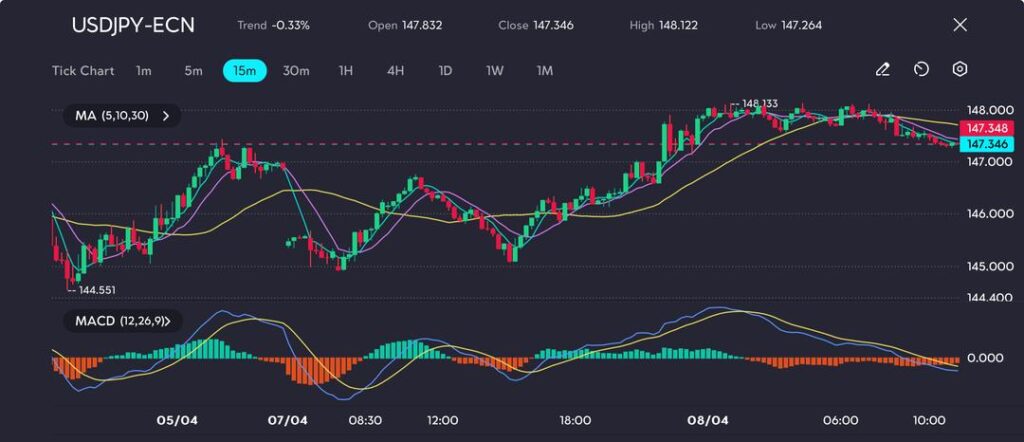
Key Points
- USD/JPY retraced from a high of 148.133 to 147.346, as safe-haven flows lifted the yen amid global trade tensions.
- Japan’s current account surplus hit a record high in February, driven by strong exports and weaker imports.
The Japanese yen found renewed strength on Tuesday, climbing back toward 147 per dollar and reversing previous session losses. This shift came amid growing market anxiety over the deepening U.S. trade conflict and ahead of expected negotiations between Tokyo and Washington. The USD/JPY pair, which touched a peak of 148.133, closed the session at 147.346, reflecting a broad move toward safety assets.
U.S. President Donald Trump confirmed plans to meet with Japanese officials for high-level trade discussions after a direct call with Prime Minister Shigeru Ishiba. U.S. Treasury Secretary Scott Bessent will lead the delegation, with talks expected to address a wide range of issues including tariffs, non-tariff barriers, currency policies, and government subsidies. Despite these diplomatic overtures, Trump denied reports suggesting a delay to the upcoming reciprocal tariffs. Instead, he stated that levies “could remain in place indefinitely,” maintaining pressure on global trade.
Technical Analysis
On the 15-minute chart, USD/JPY showed signs of exhaustion after peaking at 148.133. The pair reversed direction and began a slow decline, falling below the 5-period and 10-period moving averages. The MACD (12,26,9) also crossed to the downside, signalling a loss of bullish momentum. The next support appears near the 147.00 psychological level, with heavier downside possible if risk-off sentiment continues.

Picture: USDJPY stalls after strong rally—bulls losing steam near 148.13, as seen on the VT Markets app
Trend watchers should note that while the pair has been in a broad uptrend since touching 144.551, this current pullback may reflect investor hesitation ahead of uncertain negotiations.
Yen Supported by Domestic Fundamentals
Beyond the geopolitical headlines, the yen is also riding on solid macroeconomic data. Japan’s current account surplus surged to a record high in February, bolstered by export-led growth and a marked decline in import volumes. This reflects not just resilient demand for Japanese goods abroad, but also improved trade balance conditions that reinforce the underlying strength of the yen.
These twin forces—external risk aversion and strong internal fundamentals—are working in tandem to support the yen’s recovery. The currency’s traditional role as a safe haven is coming back into focus, especially as equity markets remain volatile and U.S. policy direction grows more unpredictable.
Cautious Outlook
The upcoming U.S.–Japan trade dialogue presents a wildcard for the USD/JPY outlook. A successful diplomatic outcome could temper demand for the yen, while failure—or further tariff threats—could intensify safe-haven flows. In the short term, the yen is likely to remain firm, especially if the S&P 500 and other risk assets continue their bearish trajectories.
Traders should keep a close eye on verbal cues from U.S. and Japanese officials, as well as technical levels near 147.00 and 146.50, which may act as short-term supports. A break below these could open the door to a more extended retracement.









